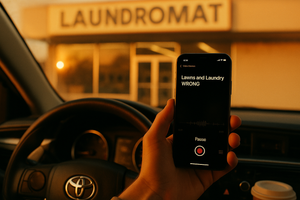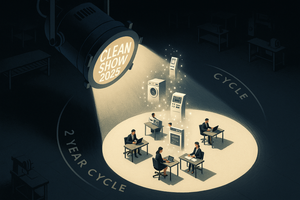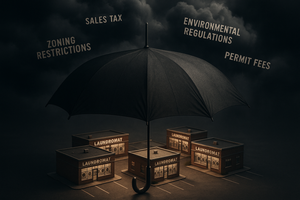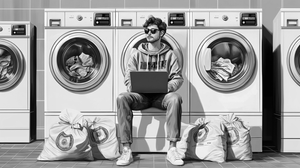I was driving when it hit me.
I grabbed my phone and started recording a voice memo, just rambling thoughts as they came. Something had clicked about customer behavior that completely shattered the way I'd been thinking about our industry for years.
The realization? I've been using the wrong analogy, and I'm not the only one.
The Lawn Care Story We Believed
A few years back, I made a LinkedIn post comparing laundry outsourcing to lawn care outsourcing. The logic seemed airtight.
The landscaping industry had exploded. In the last decade, the number of landscaping businesses grew 39%, reaching 647,741 companies across the U.S.⁷ The trend was clear, people who used to mow their own lawns were hiring landscapers instead.
So the thinking went, if people stopped doing their own yard work and outsourced it, they'd eventually do the same with laundry. Time scarcity, disposable income, changing social norms. The factors that drove lawn care outsourcing would drive laundry outsourcing too.
It made perfect sense. The post got engagement. Others in the industry used the same comparison in conversations and online.
It felt right. It sounded smart.
It was wrong.
But there's something else I missed beyond just the demographics. Lawn care isn't personal. It's grass. You want it to look good. You take pride in how the property looks. But that's where it ends.
Laundry is different. Clothing is deeply personal. That shirt a loved one gave you. The outfit that makes you feel powerful. The dress that makes you feel confident. Clothes carry meaning. They're how people express themselves. They make you feel a certain way when you put them on.
There's an emotional connection to laundry that doesn't exist with lawn care. That makes the comparison even more flawed than I initially realized.
The Flaw in the Foundation
Here's what I missed, homeowners who hire landscapers and people who use laundromats, laundry rooms are two different demographic groups.
If you're hiring someone to mow your lawn, you probably own that home (maybe rent it). Different income level. Different priorities. Different economics. Different life circumstances.
The lawn care analogy wasn't wrong because the trend didn't exist. It was wrong because it applied to the wrong people. I was comparing apples to oranges and calling it market research.
What I Saw Instead
The realization came from watching our own team members.
I'd hear about money being tight, economic challenges, budgets stretched thin. Then I'd see those same people routinely taking Ubers and Lyfts instead of the bus or train. Ordering takeout and DoorDash instead of cooking.
During pickup and delivery runs, I started noticing takeout bags at clients homes. People were making these choices consistently.
It wasn't isolated. It was a pattern.
These weren't people with unlimited funds making careless decisions. These were people choosing to spend more money on convenience and what they wanted, even when cheaper options existed.
The insight: People spend money on what they want, period. Regardless of income level. (The Psychology of Money: Timeless lessons on wealth, greed, and happiness)
Then Came the Bombshell
DoorDash partnered with Klarna to offer buy-now-pay-later for food delivery.
Let me say that again. You can now finance your DoorDash order in four installment payments.
A meal you're going to eat in 20 minutes. Financed. Like a car. Like an appliance. Like a house. Like major purchases people typically save for or plan around.
The partnership specifically targets mid-to-low income earners who can divide purchases over $35 into four equal, interest-free installments or defer payments to align with payday schedules.¹ ² The broader buy-now-pay-later market is exploding. In 2024, 86.5 million Americans used BNPL services, and the U.S. market reached $109 billion. By 2030, it's projected to hit $184 billion.¹⁰
Critics have called this partnership a sign of economic distress rather than convenience. Some experts warn that "using BNPL for essentials like food is a sign of economic distress rather than sound financial planning, possibly setting up vulnerable households for debt traps."³ ⁴
Others have gone further, calling it a "crisis" if consumers need loans for basic needs like meals and groceries.⁵ ⁶
But here's what matters for our industry, people across income levels are willing to finance convenience. This isn't just about one demographic. Higher earners and middle income earners also use laundry services. The DoorDash example simply illustrates how willing people are to pay for convenience, even when it means going into debt.
If they'll finance food delivery, what does that tell us about the opportunity to position laundry services as worth paying for?
The Analogy That Actually Works
Want to predict laundry outsourcing behavior? Don't look at homeowners and landscapers.
Look at meal prep and cooking outsourcing.
The U.S. food delivery industry tripled in revenue over five years, growing from $8.7 billion in 2015 to $26 billion in 2020.⁸ By 2033, it's projected to reach $74 billion.⁹ People used to cook at home. Now they get DoorDash, meal kits, and meal prep services.
Same demographic who might outsource laundry. Same capability to do it themselves. Same value proposition around convenience, time, and mental load. Same behavior shift from DIY to outsourcing.
That's the parallel that makes sense.
The Industry Miss
Here's the uncomfortable truth.
If the food delivery industry can convince people to finance a burrito, but if we can't convince those same people to pay for a service that gives them back 2-3 hours per week...
That's not a customer problem.
That's our failure.
The food delivery industry made it culturally acceptable. They removed the stigma. They created aspirational branding around convenience. They made the value crystal clear.
The laundry industry? We haven't removed the "I should do this myself". We haven't made it culturally normal.
Our potential clients are already spending money on convenience. They're already outsourcing daily tasks they could do themselves. They're even willing to finance those decisions.
We just haven't made the case for why laundry should be one of those things.
Thinking about the thinking of laundry:
When you realize your clients will finance a burrito but won't pay for laundry service, the problem isn't them.
The Question
So here's my challenge to you.
Don't assume you know what your clients can or can't afford. Don't base your strategy on comparisons to different demographic groups doing different things.
Watch what your potential clients are actually spending on. What are they prioritizing? What are they already outsourcing?
The lawn care analogy sounded good, but it was based on the wrong customers making different choices for different reasons.
What other assumptions are we making about who our clients are and what they value?
That's all I got for you today.
Waleed
P.S.: Just want to say thank you to everyone who joined us at the Laundry CEO Forum. Your presence was felt.
Echoing the thoughts of Peter Drucker.
The most important thing in communication is hearing what isn't being said.
Footnotes:
¹ DoorDash and Klarna Forge Buy Now, Pay Later Alliance
² DoorDash partners with Klarna
³ DoorDash, Klarna buy now, pay later food delivery debt
⁴ DoorDash, Klarna buy-now-pay-later food, debt
⁵ Klarna DoorDash buy now pay later recession
⁶ Klarna DoorDash buy-now-pay-later recession
⁷ Landscaping Statistics
⁸ 50 Online Ordering & Food Delivery Statistics
⁹ United States Online Food Delivery Market Forecast 2033
¹⁰ Buy Now, Pay Later Statistics





